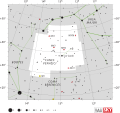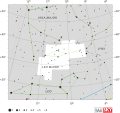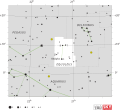A deep-sky object (DSO) is any astronomical object that is not an individual star or Solar System object (such as Sun, Moon, planet, comet, etc.). The...
9 KB (1,054 words) - 20:20, 15 April 2025
Deep sky may refer to: Deep-sky object, a classification of astronomical objects located outside the Solar System Deep Sky, a 2023 American documentary...
354 bytes (81 words) - 11:55, 28 April 2025
discovered in 1988 in a deep-sky survey. Its centre is approximately 1.5 billion light-years away. Canes Venatici contains five Messier objects, including four...
23 KB (2,380 words) - 22:31, 3 May 2025
objects, and many objects on the list are still referenced by their Messier numbers. The catalogue includes most of the astronomical deep-sky objects...
69 KB (2,268 words) - 21:52, 2 May 2025
Scorpius (section Deep-sky objects)
location straddling the Milky Way, this constellation contains many deep-sky objects such as the open clusters Messier 6 (the Butterfly Cluster) and Messier...
15 KB (1,482 words) - 18:25, 6 March 2025
Sagittarius (constellation) (section Deep-sky objects)
Sign". Herong Yang. Retrieved 22 December 2022. Levy, David H. (2005). Deep Sky Objects. Prometheus Books. ISBN 978-1-59102-361-6. Ridpath, Ian; Tirion, Wil...
25 KB (2,909 words) - 22:13, 3 May 2025
Lynx (constellation) (section Deep-sky objects)
and takes 4.35 days to complete a revolution. Lynx's most notable deep sky object is NGC 2419, also called the "Intergalactic Wanderer" as it was assumed...
40 KB (4,595 words) - 04:40, 4 May 2025
Andromeda (constellation) (section Deep-sky objects)
its color visible to the naked eye. The constellation's most obvious deep-sky object is the naked-eye Andromeda Galaxy (M31, also called the Great Galaxy...
49 KB (4,921 words) - 17:08, 4 May 2025
Volans (section Deep-sky objects)
Maddocks: Deep-Sky Name Index 2000.0 (Foxon-Maddocks Associates, 1991) Sky Catalogue 2000.0, Volume 2: Double Stars, Variable Stars and Nonstellar Objects (edited...
7 KB (726 words) - 09:46, 9 March 2025
Gemini (constellation) (section Deep-sky objects)
clickable Gemini WikiSky: Gemini constellation Ian Ridpath's Star Tales: Gemini APOD Pictures of Gemini and Deep Sky Objects: A Spring Sky Over Hirsau Abbey...
20 KB (2,270 words) - 02:22, 23 March 2025
Caldwell catalogue (redirect from Caldwell Object)
deep-sky objects for observation, Moore noted that Messier's list was not compiled for that purpose and excluded many of the sky's brightest deep-sky...
33 KB (756 words) - 22:18, 17 April 2025
Leo Minor (section Deep-sky objects)
two pairs of interacting galaxies, and Hanny's Voorwerp, a unique deep-sky object. The classical astronomers Aratus and Ptolemy had noted the region...
41 KB (3,905 words) - 04:43, 4 May 2025
Eridanus (constellation) (section Deep-sky objects)
cloud object. Another meteor shower in Eridanus is the Omicron Eridanids, which peak between November 1 and 10. Eridanus is depicted in ancient sky charts...
14 KB (1,498 words) - 20:08, 15 March 2025
Orion (constellation) (section Deep-sky objects)
interesting deep-sky objects, including M43, M78, as well as multiple stars including Iota Orionis and Sigma Orionis. A larger telescope may reveal objects such...
47 KB (5,220 words) - 18:10, 4 May 2025
Vela (constellation) (section Deep-sky objects)
system to the Solar System, was announced on 11 March 2013. Of the deep-sky objects of interest in Vela is a planetary nebula known as NGC 3132, nicknamed...
22 KB (2,549 words) - 01:46, 28 February 2025
Caelum (section Deep-sky objects)
rather devoid of deep-sky objects, and contains no Messier objects. The only deep-sky object in Caelum to receive much attention is HE0450-2958, an unusual...
24 KB (2,501 words) - 03:25, 7 May 2025
Scutum (constellation) (section Deep sky objects)
well as a globular cluster and a planetary nebula. The two best known deep sky objects in Scutum are M11 (the Wild Duck Cluster) and the open cluster M26...
16 KB (1,382 words) - 20:19, 7 May 2025
Columba (constellation) (section Deep-sky objects)
("Ship of the sky following a course in the sky"), perhaps misunderstanding "οὐριο-" as "up in the air or sky" by analogy with οὐρανός = "sky". 1679: Halley...
9 KB (895 words) - 14:48, 25 March 2025
Taurus (constellation) (section Deep-sky objects)
H. (2005). Deep Sky Objects. Prometheus Books. ISBN 978-1-59102-361-6. O'Meara, Stephen James (2011). Deep-sky companions: the secret deep. Cambridge...
38 KB (3,908 words) - 00:11, 29 January 2025
Dorado (section Deep-sky objects)
Dorado contains part of the Large Magellanic Cloud, it is rich in deep sky objects. The Large Magellanic Cloud, 25,000 light-years in diameter, is a satellite...
13 KB (1,470 words) - 00:57, 28 February 2025
Vulpecula (section Deep-sky objects)
Charles Messier in 1764 as the very first object of its kind. It can be seen with good binoculars in a dark sky location, appearing as a dimly glowing disk...
14 KB (1,389 words) - 22:52, 1 March 2025
is the passage of a celestial object (such as the Sun, the Moon, a planet, a star, constellation or a deep-sky object) across the observer's local meridian...
10 KB (1,217 words) - 06:39, 25 January 2025
Monoceros (section Deep-sky objects)
Astronomie. Frankfurt. 1564. Allen 1899, p. 290. Levy, David H. (2005), Deep Sky Objects, Prometheus Books, ISBN 1-59102-361-0 Ridpath, Ian; Wil Tirion (2007)...
13 KB (1,384 words) - 22:21, 3 May 2025
Messier 103 (redirect from Messier Object 103)
1781 by Pierre Méchain, but later added as Charles Messier's last deep-sky object in his catalogue. It is located 9,400 light-years from the Sun and...
6 KB (581 words) - 17:16, 13 March 2025
Capricornus (section Deep-sky objects)
Piscis Austrinus, and Aquarius. The constellation is located in an area of sky called the Sea or the Water, consisting of many water-related constellations...
15 KB (1,566 words) - 00:31, 28 February 2025
Draco (constellation) (section Deep-sky objects)
which has been confirmed to be orbited by Kepler-10b. One of the deep-sky objects in Draco is the Cat's Eye Nebula (NGC 6543), a planetary nebula approximately...
19 KB (2,282 words) - 18:22, 28 March 2025
Equuleus (section Deep-sky objects)
Information". The NGC/IC Project. Retrieved 2024-03-25. "Deep sky objects in Equuleus - Full list". The Sky Live. Retrieved 2024-03-25. Olcott, William Tyler...
10 KB (1,049 words) - 20:19, 2 April 2025
Aquila (constellation) (section Deep-sky objects)
nebula is estimated to be roughly 0.8 light-years in diameter. More deep-sky objects: NGC 6709 is a loose open cluster containing roughly 40 stars, which...
36 KB (3,872 words) - 01:10, 3 March 2025
Serpens (section Deep-sky objects)
passes through Serpens Cauda, which is therefore rich in galactic deep-sky objects, such as the Eagle Nebula (IC 4703) and its associated star cluster...
119 KB (11,800 words) - 06:08, 21 April 2025
Libra (constellation) (section Deep-sky objects)
by constellation Objects of magnitude 6.5 are among the faintest visible to the unaided eye in suburban-rural transition night skies. While parts of the...
15 KB (1,576 words) - 19:02, 27 March 2025




























